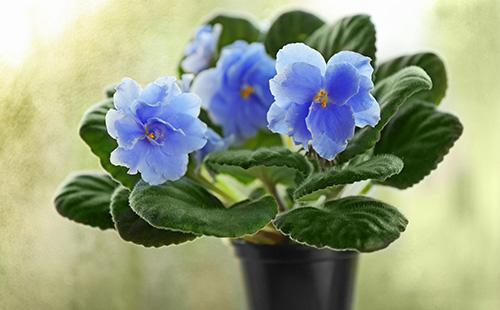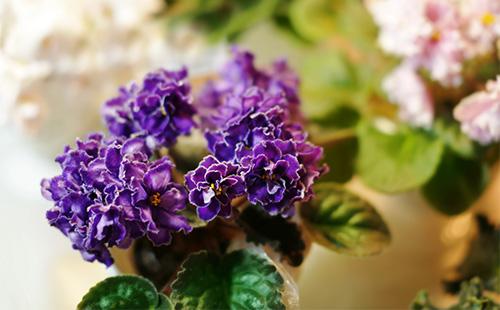The content of the article
If the violet is kept in favorable conditions, receives the necessary amount of nutrients, the incidence rate is not so high. Most of the problems are associated with care errors. You can save the violet from death only with timely treatment.
Main pests
If preventive treatment of violets from pests is not carried out, insects quickly attack the flower, often leading to its death. The danger is neighboring affected indoor plants, poor-quality soil. The main pests of violets are the following.
Ticks
Microscopic insects feeding on plant sap. There are several types of ticks. In any case, the violet gradually withers, loses its decorative effect. Without treatment, dies.
- Spider mite. Its appearance is easy to notice by the thinnest cobweb, entangling the plant. The leaves turn brown, deformed, and dry over time.
- Cyclamen tick. The central part of the outlet is primarily affected. Young leaves are condensed, covered with yellow spots. Growth is inhibited, flowering stops.
- Tick flat-bodied. It is less common in cobweb and cyclamen, but quickly leads to the death of the flower. In violets, the leaves curl inward, gradually fading.
Methods of struggle
Combined therapy is recommended - simultaneous spraying and watering the soil with acaricide solution. Single processing is not enough. It is repeated three times at intervals of about a week. The most effective means are Actellik, Fitoverm.
Scaffold and false scaffold
Scutellum is a small insect with a dense protective shield. In the adult stage, they look like dense plaques on the petioles of the leaves and the leaves themselves. It is difficult to separate from the sheet. The leaves of the violet begin to fade, covered with a sticky coating. Brownish spots appear. Insects feed on the plant sap, leading to its death.
Methods of struggle
Pests are removed mechanically by wiping the leaves with a cotton swab dipped in alcohol. Be sure to spray with the drug "Agravertin". With a minor lesion, one treatment is enough. With an abundance of insects, they are treated again after a weekly interval.
Thrips
Thrips fall into a house with garden flowers. Settle inside flowers, destroy anthers. Small holes appear on the petals, brown spots appear on the leaves. Violets with blue flowers are most affected by thrips.
Control measures
All parts of the plant damaged by the pest are immediately removed. The flower is sprayed with a solution of Actellik, Fitoverm or Aktara.Thrips are displayed heavily, a single treatment is usually not enough. For reliability, spray three or four times with weekly intervals.
Nematodes
One of the most dangerous pests. They live in the soil, damage the roots of violets. They look like microscopic worms. You can only detect them during a transplant by characteristic gall swelling on the roots. They suck out the juice, cause the plants to rot. In the initial stages, light green spots appear. Later signs of rot appear.
Methods of struggle
In the initial stages, the violet is transplanted with the removal of all affected parts. Old soil and pot are thrown away. The new soil is calcined in the oven or in a pan. A new, quite effective remedy is the Vidat nematicide. It copes with all types of nematodes - gall, leaf, stem. In the later stages, it is not possible to reanimate a room violet.
Mealybug
The violet withers, the buds dry out, growth is inhibited. The decorativeness of the plant is reduced - it looks painful, faded. Sometimes a whitish coating appears on the leaves. Mealy root mealybug lives in the soil, affects the root system. When transplanted on the roots, white lumps resembling cotton wool can be found. Gives the presence of the vermilion a characteristic sour smell coming from the soil.
Control measures
Violet is transplanted without fail. The roots are cleaned of residual soil, remove damaged areas. The root system is treated with a solution of the drug "Actara". Use a new pot and soil. To prevent the reappearance of the worm, Bazudin is added to the planting soil.
Aphid
Another reason why the violet leaves twist inward is the appearance of aphids. Aphids are the most common pest of indoor and garden crops. Colonies of small insects settle on the inside of the leaf, suck out the juices from it. The leaves are covered with a sticky coating, the flower petals are deformed, the leaves curl and wither. Sticky plaque often causes secondary infection with soot fungus.
Methods of struggle
In the early stages of the lesion, when the insects have not yet formed numerous colonies, the leaves are carefully treated with a soap solution. After a few minutes, the soap is washed off with clean water, the remaining moisture is removed with a dry soft cloth. Judging by the reviews, the soap solution does not always give good results. It is better to immediately spray the violet with special chemicals. The Mospilan and Actellik funds have proven themselves well.

Woodlice
They love moist, loose soil. In the daytime, insects rarely appear. Activity occurs at night. Damage the leaves and roots of violets. Young plants often die. Adults begin to hurt, they lose their resistance to secondary infections.
Methods of struggle
The most effective way is to use acaricides. The preparations Envidor, Oberon, and Vermitek have proven themselves well.
Mosquitoes and midges
If the soil is regularly waterlogged, flies and mosquitoes appear. They lay larvae in the soil.As larvae develop, the soil gradually compacts, and rot of the root system develops. At later stages leaf petioles rot. Especially great harm is caused to insect larvae by young plants with a weak root system.
Methods of struggle
To destroy the larvae, the soil is watered with a solution of malathion. Adults get rid of by spraying any means against flying insects (for example, "Raid"). If this is not done, the reappearance of larvae in the soil is not ruled out.
Whitefly
It looks like a very small white butterfly. Settles whitefly on the back of the leaves. Leaves are covered with a brilliant coating. The danger is not so much the insect itself as the consequences. Plaque-covered areas are often affected by soot fungus. Dark spots appear on the leaves of the violet, resembling soot, growth stops, the plant gradually dies.
Methods of struggle
The treatment is complex. Simultaneous treatment with acaricides and systemic insecticides is recommended. They are mixed before use. A good combination of “Akarin” and “Fitoverm”. Processing is repeated, with intervals of 5-8 days.
Diseases and treatments
Fungal and infectious diseases pose no less threat. Many of them are treatable only in the initial stages. Therefore, it is necessary to treat violets from diseases in a timely manner and until complete recovery.

Fusarium
A dangerous fungal disease that affects the root system of violets. Roots and stems begin to rot. In the initial stages, brown spots appear on the petioles of the leaves. Without treatment, the leaves fall off, the root neck blackens and separates from the soil. In most cases, the plant dies.
Treatment methods
Violet is transplanted into fresh, sterile soil. Pre-rotted, affected parts are removed and treated with carbon powder. Old soil and pot are thrown away. The plant is repeatedly treated with fungicides, combining watering and spraying.
Powdery mildew
Another fungal disease. Prone to rapid spread. The first sign of a fungus is dusty white coating on violet flowers, leaves. The provoking factors are cold, high humidity, poor lighting or an overdose of nitrogen fertilizers. The whole aerial part is affected.
Treatment methods
Treatment of powdery mildew on violets - a single spray with a solution of Benlat or Fundazol preparations. If signs of the disease persist after a week, you can re-treat.
Late blight
Dangerous disease caused by spores of the fungus. Penetrates plant tissue through damaged areas of leaves or roots. Causes the appearance of brown spots on the leaves, rotting of the root neck. Late blight often affects weakened plants. Cold and high humidity provoke the rapid development of the fungus.
Treatment methods
It is useless to treat late blight. You can try to spray the violet with fungicides, but do not count on a positive effect. Correct action - the diseased violet is immediately thrown out with the pot and taken out of the apartment. Neighboring plants are prophylactically treated with fungicides, introduce a small amount of superphosphate into the soil, and ventilate the room well.
Gray rot
Among the diseases of violet flowers, the appearance of gray rot is dangerous. It can be detected by a grayish or brownish fluffy coating on all aerial parts of the plant. Rot spreads very quickly, literally in a few days leads to the death of violets.
Treatment methods
Treatment begins when the first signs of the disease appear. Affected parts are immediately cut off. Transplantation into sterile soil with treatment of the root system and the aerial parts with fungicides is recommended. Watering is minimized, maintain a stable temperature without pronounced fluctuations. Heavily affected plants are thrown away immediately - they will not succeed in saving.

Rust
The appearance of red tubercles on the outside of the leaf is characteristic. Over time, the affected areas crack, spores spill out of them. From this moment, the disease spreads rapidly, causing leaf decay. Sometimes a calcite burn, which occurs when the violet is regularly irrigated with hard water, can be confused with rust. A layer of salts accumulates on the surface of the soil. When the leaves come into contact with the soil, brown spots appear.
Treatment methods
Violet is sprinkled with sulfur dust, sprayed with a solution of Bordeaux liquid of 1% concentration or any fungicide. Processing is carried out in the initial stages of the disease. After spreading the spores, treatment becomes more complicated.
Vascular bacteriosis
Hot summers are ideal conditions for the development of vascular bacteriosis. Leaves become translucent, fade, gradually die. Treatment is started immediately.
Treatment methods
Lower the temperature of the content, regularly ventilate the room. Violet is sprayed with one of the drugs - Previkur, Fundazol, Zircon.
Violet (more about flower) - capricious, tender plant. It is necessary to closely monitor it, create favorable conditions for growth and flowering. Diseases and pests of violets in most cases are the result of improper, inadequate care.

